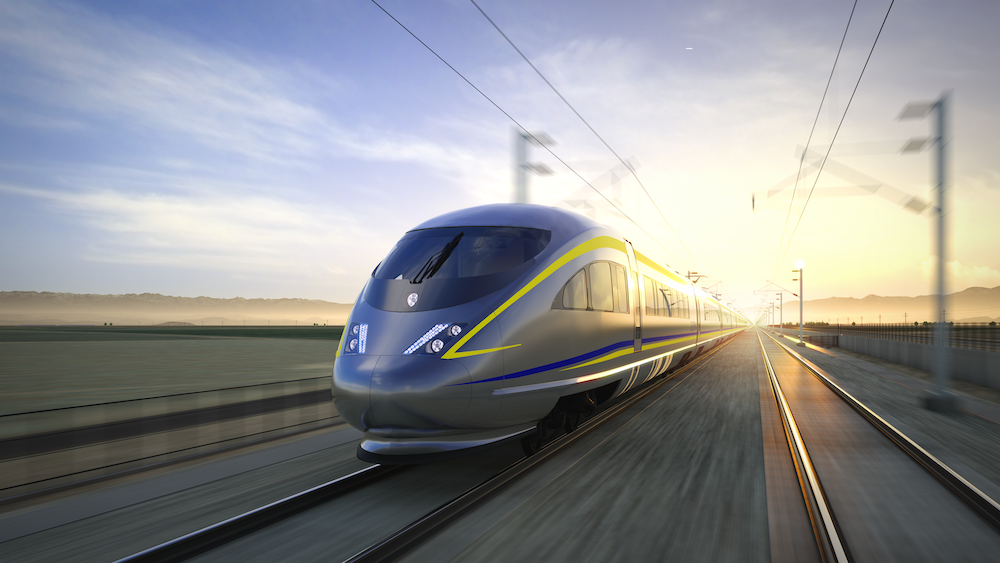Caltrain Completes Electrification Between San Francisco and San Jose Caltrain, with partners Pacific Gas and Electric Company (PG&E) and Balfour Beatty, has completed energization of the 51-mile corridor between San Francisco and San Jose. Caltrain can now begin...
California’s high-speed line from San Francisco to Los Angeles is the biggest public-works project now underway in America. Its payoffs will be felt in every corner of the state and every sector of the California economy. It’s the foundation for a sustainable future—not only in California but across the U.S. It’s a paradigm-shattering project that will put the state at the cutting edge of a global shift toward sustainable transportation systems.
It could do and be all of these things—but only if California fully commits to it. And that depends on the California Legislature, as details of next year’s state budget are negotiated over the coming weeks. It also depends on us, as advocates for high-speed rail.
The stakes couldn’t be higher. California prides itself on being the nation’s leader in innovation and forward-thinking sustainability projects. This is its moment of truth. An all-in commitment by the State Legislature would create a tipping point for HSR in the U.S. But for that to happen, the legislature must move beyond its current half-in approach, which leaves high-speed rail always on the knife’s edge.
Right now, for example, the project is at a crossroads as it appears the California Assembly and Gov. Gavin Newsom (D) differ over how to use $4.2 billion in voter-approved funds. That money is the remaining tranche from the $9 billion approved in a 2008 referendum authorizing the California High Speed Rail Authority to begin building the system.
Newsom wants the Legislature to appropriate the money to complete the first, 171-mile segment of line, currently under construction in the Central Valley. Two key members of the Assembly—Speaker Anthony Rendon (D) and Assembly Transportation Chair Laura Friedman (D)—support the project’s broad goals, which will deliver a single-seat ride from San Francisco to LA in 2 hours, 40 minutes. But they have frequently said they want to divert money to projects in the Los Angeles area, where their districts are located. “This strict adherence to the current project is not really what we’re interested in,” Rendon recently said.
Here are three crucial points to keep in mind.
1. This project is still very popular. Californians believe in it and want the state to build the full, San Francisco-to-Los Angeles line. Fifty-six percent of registered voters in California supported it in a poll from April conducted by UC Berkeley and the L.A. Times. The question specified that the segment in the Central Valley would be built first, and that trains would begin running in 2030.
2. It’s popular because it meets an urgent and obvious need. As a former U.S. Transportation Secretary, Ray LaHood (R), wrote last week, a “failure to move toward completion of the project would invite the dystopia that California’s most vociferous critics love to conjure: massive traffic gridlock, clogged airports, thickly polluted skies. Killing high-speed rail would put the clean, responsible growth of the world’s fifth-largest economy out of reach.”
The alternative to HSR is to keep pouring money into the same old road-building death trap. To cite just one recent and relevant example: A 12-mile expansion of I-5, north of L.A., came in more than five years behind schedule and tens of millions of dollars (at minimum) over its $1.3 billion budget. That’s for just 12 miles of expanded highway—with benefits limited mainly to commuters in Los Angeles. But even the benefits are dubious, since building more lanes almost always brings more gridlock and more fatalities.
3. It’s time for an all-in approach. With a budget surplus in California approaching $100 billion, the Assembly’s framing—HSR versus better local transit—makes no sense. The state has resources to invest in both. We agree that those local projects are important. California High-Speed Rail has long argued that as the backbone of a comprehensive rail network, they’re key to the economic vitality of the Bay Area and LA regions. And we have always been strong champions of great transit systems in general, because they generate demand for great HSR, and vice versa. Which creates a virtuous cycle of ever-improving options.
Imagine if the Legislature embraced that truth. Imagine if the globe’s fifth-largest economy went to beast mode and invested heavily in both local transit and electrified HSR. Imagine if California built a twenty-first century transportation system—i.e., one that’s sustainable, easily accessible to everyone, and a powerful driver of expanded access to jobs, opportunities, and housing.
The effects would transform transportation across America.
Let’s help make that happen. If you live in California, please sign our petition here. Even better: note the phone numbers of your representatives and call them. Talking to a staff member is guaranteed to have the biggest impact. And if you live outside of California, please take a moment to share this with people you know in the state.
Let elected officials know: It’s time for California to put its money where its mouth is when it comes to sustainability and innovation. It’s time for an all-in approach that shows America what a twenty-first century transportation system can, should—and must—be.
The Latest from HSRA
Our Latest Blog Posts
Check out the latest news, updates, and high speed rail insights from our blog!


